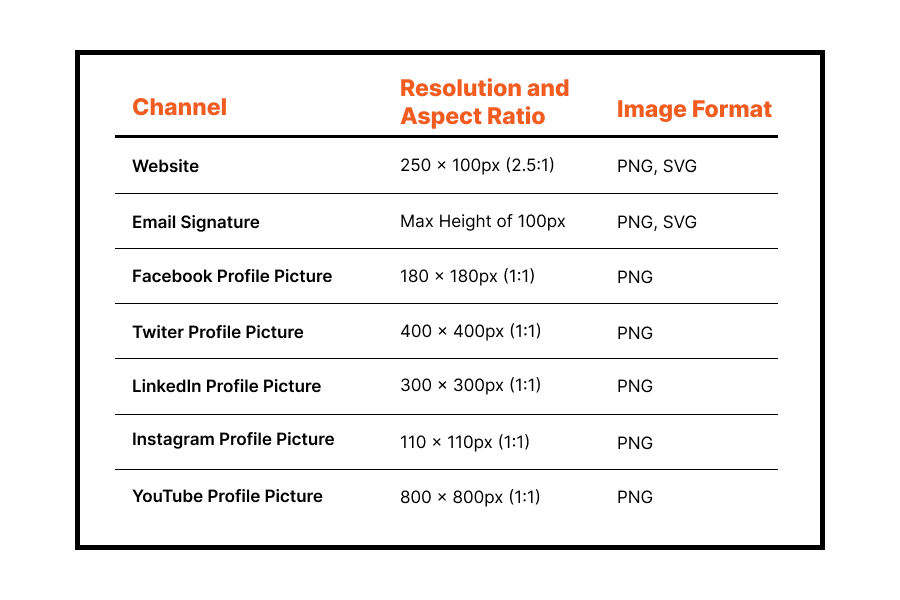Getting Your New Logo Right: A Guide for Digital Marketing


Creating or updating a logo for digital marketing channels involves understanding the aspect ratios, formats, and common resolutions that are needed. It is also vital to get this right for your website design as well as other social media marketing channels. Here’s some detailed information and references to help you understand what you need to do to get your logo right.
Table of Contents
60% of Taiwanese manufacturers are now incorporating digital marketing strategies into their export plans, so understanding the nuances of B2B vs. B2C branding becomes crucial for international success. For Taiwan-based B2B manufacturers, many of whom are steering their family-owned businesses towards new global markets, grasping these differences can be the key to unlocking new opportunities and expanding their international footprint.


Logo aspect ratios for digital marketing channels
The aspect ratio of a logo depends on the platform it’s being uploaded to.In the table below are the most common formats that you need to consider when creating a logo:


Logo formats for digital marketing
Logos should be easy to resize and adapt. Therefore, having PNG and vector logo files is crucial. PNG files are lossless compressed files, which allows them to maintain a lot of quality while having a relatively small file size. They also allow for transparency / transparent backgrounds and are great for social media, websites, and most other web use cases. Vector files are necessary as they can be infinitely scaled and retain their quality when resized.
- Use PNG for most logos
- USE Vector (Adobe AI) for editing and resizing.
Keep your logo design simple enough that it works at lower resolutions
Simplicity is key when it comes to logo design. A logo must maintain its clarity and impact, even at lower resolutions. This is because logos are often viewed on a variety of platforms and devices, each with different display capabilities. A complex logo might lose its details and become unrecognizable when scaled down for smaller screens or lower resolution displays.
It’s crucial to keep your logo design simple and versatile. This ensures that it remains effective and identifiable, whether it’s being viewed on a large desktop monitor or a small mobile device screen. Remember, a logo is the visual representation of your brand, and its effectiveness lies in its ability to be instantly recognized, regardless of where or how it’s displayed.
Here are some other key points to remember when designing a logo:
- Do not include multiple languages in one logo
- Avoid fine lines or gradients as they will disappear at smaller sizes
- Do not have too many words in the logo
Create a Branding Guide
When you have finished the initial logo design you should then create a branding guide that your company and suppliers can use when using your branding. A branding guide is a comprehensive document that outlines how your brand should be represented. It includes everything from your brand’s story or identity, official brand name, logo and how it should be used, to your official brand color palette. Here are some steps to create a branding guide:
- Define Your Brand’s Story or Identity: This includes your brand’s mission, values, and personality.
- Present Your Official Brand Name: This is the name that will be associated with your products or services.
- Explain Your Logo and How It Should Be Used: This includes guidelines on where and how your logo should be displayed.
- Present Your Official Brand Color Palette: This includes the specific colors that represent your brand.
- Outline How Brand Fonts Are Used: This includes the specific fonts that should be used in your brand materials.
- Spell Out Your Brand Voice: This includes the tone and style of language that should be used when communicating as your brand.
- Include Image and Data Viz Guidelines: This includes guidelines on how images and data visualizations should be used in your brand materials.






Remember, a branding guide helps maintain consistency across all your marketing materials and platforms. It’s a crucial tool for any B2B company looking to establish a strong and recognizable brand.
I also have another article about B2C vs B2B branding that explains the difference between logos and brands and their varying application in B2B and B2C marketing which might be interesting further reading for you.
If you would like advice on B2B branding and marketing for your business, please contact us.
